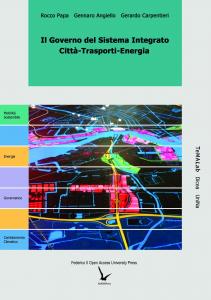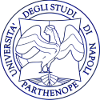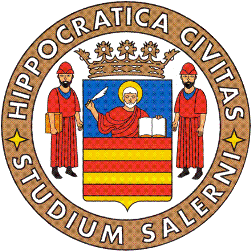Integrating Land Use, Transport and Energy Planning
Keywords:
Sustainable Mobility, Energy, Urban SystemSynopsis
Publisher: FedOA Press (Federico II Open Access University Press).
Series: Smart City, Urban Planning for a Sustainable Future.
Pages: 151.
Language: Italian.
NBN: http://nbn.depositolegale.it/urn:nbn:it:unina-22033
Abstract: Theories about the origins and developments of modern cities seem to agree, without exception, to a point: the city is the place of maximum concentration of exchange. Activities, in fact, are located into urban and metropolitan agglomerations to minimize the resources needed to meet the growing need for relationships and exchanges with other activities. In recent years, the concentration and specialization of these activities have led to an extraordinary increase in intensity and quality of exchange needs, with the obvious consequence of congestion in most metropolitan areas with predictable consequences on the sustainability of urban areas, on the quality of life of its inhabitants and on the energy consumption associated with the growing demand for mobility. As a result, in recent years, several authors have argued for greater integration between urban planning policies, mobility management and energy efficiency. In this context, this volume aims to provide a contribution in this direction and presents the results of a research project aimed at the development of an integrated city-mobility-energy governance model.
In particular, the first part of this work give an overview of the complex relationships between mobility, energy consumption and built environment through a meta-analysis of the recent literature. Specifically, in this section, the two main sources of energy consumption in urban areas (energy consumption in the residential sector and energy consumption of transport) are considered. These sectors represent, according to the latest estimates, respectively 32% and 35% of the final energy consumption. The section introduces several characteristics of the built environment such as density, functional mix or accessibility and described as such factors affect energy consumption in the transport and residential sectors. Understanding these relationships is of crucial importance for the development of a coordinated mix of actions aimed at reducing energy consumption in urban areas. Subsequently, the main models present in the literature for estimating residential energy consumption and urban transport energy consumption are presented, paying particular attention to the strengths and weaknesses of each model, the complexity and the related technical and operational aspects related to the implementation of such models.
In the second part of this work, the focus is on the techniques for the representation and classification of energy consumption in urban areas through an application to the case study of Naples. Particularly, this section places particular emphasis on the new opportunities offered by the Geographic Information Systems (GIS) and by the increasing availability of new data sources. The work integrates the use of "traditional" data sources such as census surveys, new data sources (in particular open and large data) with spatial analyzes developed ad hoc to provide exhaustive knowledge of energy consumption patterns within the city of Naples. The proposed methodology is validated by comparing the results obtained with the previously available data for the study area and by the implementation of spatial statistical analyzes in a GIS environment. The proposed methodology is a useful tool for public decision-makers and policy makers aimed at defining integrated government strategies for the reducing and optimizing of public and private energy consumption. In particular, the methodology described in this work is useful for classifying and representing energy consumption on an urban scale, for the identification of critical areas in terms of consumption, and for ex post evaluation of interventions on the urban system.
Finally, the last part of the paper proposes an analysis of the tools, actions and best practices for reducing energy consumption in urban areas. Particularly, in this chapter the most important mobility planning tools are presented, describing for each of them the main objectives, contents and modes of implementation. Two new governance tools for territorial transformations, the Municipal Energy Action Plan and the Sustainable Energy Action Plan are also introduced, which define the energy policies of the Communes, aimed at achieving targets for the reduction of climate change emissions, efficiently energy and use of renewable energy sources. Subsequently, a reasoned synthesis of the actions that individual municipalities can put in place to contain energy consumption in the transport sector is presented. These actions are organized in the form of guidelines and action policies, where action policies represent operational specification of the first. Finally, the last part of the chapter presents some case studies of urban mobility interventions aimed at energy saving in some Italian and European cities. These are particularly relevant cases, examples of mobility capable, on the one hand, of optimizing the use and development of energy resources through traditional fuel economy savings and incentives for the use of renewable energy sources and, on the other hand, to meet the new needs of transporting people and goods safely and efficiently.
Downloads
References
Agence de l'Environnement et de la Maîtrise de l'Energie, 2012. Energy Efficiency Trends in Transport in the EU. Available at: http://www.odyssee-mure.eu/publications/efficiency-by-sector/transport/transport-eu.pdf.
Anderson, B., Chapman, P., Cutland, N., Dickson, C., Doran, S., Henderson, G., Henderson, J., Iles, P., Kosmina, L. and Shorrock, L. (2002) BREDEM-8: model description 2001 update. Building Research Establishment, UK. Available at: http://www.iea.org/media/statistics/eemanual/UK_BREDEM_model_description.pdf.
Aydinalp, M., Ismet Ugursal, V., & Fung, A. S. (2002). Modeling of the appliance, lighting, and space-cooling energy consumptions in the residential sector using neural networks. Applied Energy, 71(2), 87-110. doi: https://doi.org/10.1016/S0306-2619(01)00049-6.
Balaras, C. A., Gaglia, A. G., Georgopoulou, E., Mirasgedis, S., Sarafidis, Y., & Lalas, D. P. (2007). European residential buildings and empirical assessment of the Hellenic building stock, energy consumption, emissions and potential energy savings. Building and Environment, 42(3), 1298-1314. doi: https://doi.org/10.1016/j.buildenv.2005.11.001.
Banister, D., Watson, S., & Wood, C. (1997). Sustainable cities: transport, energy, and urban form. Environment and Planning B, 24, 125-144.
Brounen, D., Kok, N., & Quigley, J. M. (2012). Residential energy use and conservation: economics and demographics. European Economic Review, 56(5), 931-945. doi: https://doi.org/10.1016/j.euroecorev.2012.02.007.
Brownstone, D., & Golob, T. F. (2009). The impact of residential density on vehicle usage and energy consumption. Journal of Urban Economics, 65(1), 91-98. doi: https://doi.org/10.1016/j.jue.2008.09.002.
Brundtland, G., Khalid, M., Agnelli, S., Al-Athel, S., Chidzero, B., Fadika, L., ... & Singh, M. (1987). Our common future.
Burrough P.A. (1986) - Principles of geographical information systems for land resource assessment, Clarendon Press, Oxford, U.K, 194pp. doi: https://doi.org/10.1016/j.joep.2009.05.006.
Cartenì, A., Cantarella, G. E., & Luca, S. D. (2010). A methodology for estimating traffic fuel consumption and vehicle emissions for urban planning. In 12th World Conference for Transportation Research. Lisbon, 11-15 June 2010. Available at: http://www.wctrs.leeds.ac.uk/wp/wp-content/uploads/abstracts/lisbon/general/02686.pdf.
Cascetta, E. (2009). Transportation systems analysis: models and applications. Second edition. Springer.
Cappelli M. (2008). Cluster analisys, Enciclopedia della scienza e della tecnica. Available at: http://www.treccani.it/enciclopedia/cluster-analysis_%28Enciclopedia-della-Scienza-e-della-Tecnica%29/
Centro Studi Pragma (2012). Mobilità e trasporti in tempo di crisi. Available at: www.csepragma.it.
Cervero, R., & Murakami, J. (2010). Effects of built environments on vehicle miles traveled: evidence from 370 US urbanized areas. Environment and Planning A, 42(2), 400-418. doi: 10.1068/a4236.
City Ports (2005). Progetto City Port – Rapporto Intermedio. Quaderni del Servizio Pianificazione dei Trasporti e Logistica 5. Regione Emilia Romagna - Assessorato Mobilità e Trasporti, Bologna. Available at: http://mobilita.regione.emilia-romagna.it/entra-in-regione/Pubblicazioni/quaderni-servizio-pianificazione/i-quaderni-del-servizio-pianificazione-dei-trasporti-e-logistica.
Civitas (2009). Clean bus procurement in Bremen as part of a wider strategy on sustainable urban mobility and energy efficiency. Workshop on Clean Vehicles and restricted access, Rotterdam 4.-5.11.2009.
Comi A., Delle Site P., Filippi F., Marcucci E. e Nuzzolo A. (2008). Differentiated regulation of urban freight traffic: conceptual framework and examples from Italy. Proceedings of 13th International Conference of Hong Kong Society for Transportation Studies, Hong Kong, Cina. Available at: https://iris.uniroma3.it/handle/11590/160101#.WUuQpOvyiJA.
Commissione Europea (2010). Momo Car-Sharing More options for energy efficient mobility through Car-Sharing. Grant agreement No.: IEE/07/696/SI2.499387 Deliverable 5.3. Guideline for municipalities and governments. Available at: https://ec.europa.eu/energy/intelligent/projects/en/projects/momo-car-sharing.
Corrado, V., Tala, N., Ballarini, I., & Corgnati, S. P. (2011). Building Typology Brochure-Italy. Fascicolo sulla Tipologia Edilizia Italiana. Available at: http://episcope.eu/fileadmin/tabula/public/docs/brochure/IT_TABULA_TypologyBrochure_POLITO.pdf.
De Mauro, A., Greco, M., & Grimaldi, M. (2016). A formal definition of Big Data based on its essential features. Library Review, 65(3), 122-135. doi: https://doi.org/10.1108/LR-06-2015-0061.
Dell’Isola M., Frattolillo A. e A. Massimo. (2013). Strumenti e metodologie per la pianificazione energetica territoriale. /° Congresso Nazionale AIGE-Rende (Cosenza), 10-11 Giugno, 2013. Available at: https://www.construction21.org/italia/articles/it/7-congresso-nazionale-aige.html.
EEA (2009). Final energy consumption by sector in EU-27. European Environmental Agency (EEA). Available at: http://www.eea.eu.
ENEA (2011). Quaderno “L’efficienza energetica nei trasporti”. Available at: http://www.enea.it/it/comunicare-la-ricerca/documenti/quaderni-energia/trasporti.pdf.
ENEA (2011). L’efficienza energetica nei trasporti. Available at: http://www.enea.it/it/enea_informa/documenti/quaderni-energia/trasporti.pdf.
ENEA (2014). L’ottenimento dei Certificati Bianchi – Trasporto Pubblico Locale. http://www.studiosalvatore.com/wp-content/uploads/2014/02/Lottenimento-dei-Certificati-Bianchi-Mobility-Management.pdf.
Ericson J. (2013). Bus experiences from Stockholm. Workshop “Clean Bus Procurement”, Bremen. 12 Dicembre 2013.
EPA (1999). Indicators of the environmental impacts of transportation. United States Environmental Protection Agency, Report EPA 230-R-99-001. Available at: https://nepis.epa.gov/Exe/ZyPURL.cgi?Dockey=91017QUT.TXT.
European Commission, 2007. Sustainable Urban Transport Plans - Preparatory Document in relation to the follow-up of the Thematic Strategy on the Urban Environment (Technical report No. 2007/018). European Commission, Luxembourg. Available at: https://ec.europa.eu/transport/sites/transport/files/themes/urban/studies/doc/2007_sutainable_urban_transport_plan.pdf.
Eurostat (2012). Final energy consumption by sector. Available at: http://epp.eurostat.ec.europa.eu/tgm/table.do?tab=table&init=1&plugin=1&language=en&pco de=tsdpc320.
Ewing, R., & Cervero, R. (2010). Travel and the built environment: a meta-analysis. Journal of the American Planning Association, 76(3), 265-294. doi: http://dx.doi.org/10.1080/01944361003766766.
Farahbakhsh, H., Ugursal, V. I., & Fung, A. S. (1998). A residential end‐use energy consumption model for Canada. International Journal of Energy Research, 22(13), 1133-1143. doi: 10.1002/(SICI)1099-114X(19981025)22:13<1133::AID-ER434>3.0.CO;2-E.
Fistola, R. (2009). Tecniche per il governo delle trasformazioni urbane: i metodi geocomputazionali, in Papa, R. (cur.). Il governo delle trasformazioni urbane e territoriali. Metodi, tecniche e strumenti. ISBN: 9788856811476.
Gargiulo, C. (2009). Sistema Urbano e Complessità, in Papa, R. (Ed.). Il governo delle trasformazioni urbane e territoriali. Metodi, tecniche e strumenti. ISBN: 9788856811476.
Geurs, K. T., & VAn Wee, B. (2004). Accessibility evaluation of land-use and transport strategies: review and research directions. Journal of Transport geography, 12(2), 127-140. doi: https://doi.org/10.1016/j.jtrangeo.2003.10.005.
Giffinger, R., Fertner, C., Kramar, H., Kalasek, R., Pichler-Milanović, N., Meijers, E. (2007). Smart Cities: Ranking of European medium-size cities” , Vienna: Centre of Regional Science, TU WIEN. Available at: http://www.smart-cities.eu.
Gargiulo C. (2014). Integrazione trasporti-territorio: strumenti, interventi e best practices verso la Smart City. CLEAN, Napoli.
Gargiulo, C., & Lombardi, C. (2016). Urban Retrofit and Resilience: The challenge of Energy Efficiency and Vulnerability. TeMA Journal of Land Use, Mobility and Environment, 9(2), 137-162. doi: http://dx.doi.org/10.6092/1970-9870/3922.
Gargiulo, C., & Zucaro, F. (2015). Smartness and Urban Resilience. A Model of Energy Saving. Tema. Journal of Land Use, Mobility and Environment, 81-102. http://dx.doi.org/10.6092/1970-9870/3661.
Grosso D., Lavagno D. e A.Kanudia, G.C. Tosato. (2015). Coupling World and European models: energy trade and energy security in Europe in Informing Energy and Climate Policies using Energy Systems Models Scenario Analysis Increasing the Evidence Base, Lecture Notes in Energy, Springer. doi: 10.1007/978-3-319-16540-0_22.
Giuliano, G., & Narayan, D. (2003). Another look at travel patterns and urban form: the US and Great Britain. Urban studies, 40(11), 2295-2312. doi: 10.1080/0042098032000123303.
Handy, S. L., Boarnet, M. G., Ewing, R., & Killingsworth, R. E. (2002). How the built environment affects physical activity: views from urban planning. American journal of preventive medicine, 23(2), 64-73.
Hens, H., Verbeeck, G., & Verdonck, B. (2001). Impact of energy efficiency measures on the CO2 emissions in the residential sector, a large scale analysis. Energy and Buildings, 33(3), 275-281. doi: https://doi.org/10.1016/S0378-7788(00)00092-X.
Huang, Y. J., & Brodrick, J. (2000). A bottom-up engineering estimate of the aggregate heating and cooling loads of the entire US building stock. doi: https://doi.org/10.1016/S0378-7788(00)00092-X.
ISFORT (2011). Rapporto OPMUS - Osservatorio sulle politiche per la mobilità urbana sostenibile, n.14, gennaio 2011. Available at: http://www.isfortopmus.it/.
Jenks, G. F. (1967). The data model concept in statistical mapping. International yearbook of cartography, 7(1), 186-190. doi: 10.1080/0042098032000123303.
Jones, P., Williams, J., & Lannon, S. (2000). Planning for a sustainable city: an energy and environmental prediction model. Journal of Environmental Planning and Management, 43(6), 855. Available at: http://search.proquest.com/openview/767af78badb7d8d4d0cff43de8cfc808/1?pq-origsite=gscholar&cbl=33087.
Kavgic, M., Mavrogianni, A., Mumovic, D., Summerfield, A., Stevanovic, Z., & Djurovic-Petrovic, M. (2010). A review of bottom-up building stock models for energy consumption in the residential sector. Building and Environment, 45(7), 1683-1697.doi: https://doi.org/10.1016/j.buildenv.2010.01.021.
Kavousian, A., Rajagopal, R., & Fischer, M. (2012). A Method to Analyze Large Data Sets of Residential Electricity Consumption to Inform Data-Driven Energy Efficiency. CIFE Working Paper 130, Stanford University. Available at: https://cife.stanford.edu/WP130.
Kenworthy, J. R. (2003). Transport energy use and greenhouse gases in urban passenger transport systems: a study of 84 global cities. In: International Sustainability Conference, 17 - 19 September, Fremantle, Western Australia. Available at: http://cst.uwinnipeg.ca/documents/Transport_Greenhouse.pdf.
Khattak, A. J., & Rodriguez, D. (2005). Travel behavior in neo-traditional neighborhood developments: A case study in USA. Transportation Research Part A: Policy and Practice, 39(6), 481-500. doi: https://doi.org/10.1016/j.tra.2005.02.009.
Laney, D. (2001). 3D data management: Controlling data volume, velocity and variety. META Group Research Note, 6, 70. Avalilable at: https://blogs.gartner.com/doug-laney/files/2012/01/ad949-3D-Data-Management-Controlling-Data-Volume-Velocity-and-Variety.pdf.
Liao, H. C., & Chang, T. F. (2002). Space-heating and water-heating energy demands of the aged in the US. Energy Economics, 24(3), 267-284. doi: https://doi.org/10.1016/S0140-9883(02)00014-2.
Litman, T. (2005). Evaluating transportation equity: methods for incorporating distributional impacts into transport planning. Victoria Transport Policy Institute, Canada. Available at: http://www.vtpi.org/equity.pdf.
Mancarella M. Il principio dello sviluppo sostenibile: tra politiche mondiali, diritto internazionale e costituzioni nazionali. Available at: http://www.giuristiambientali.it/documenti/20061114_AM.pdf.
Manville, C., Cochrane, G., Cave, J., Millard, J., Pederson, J. K., Thaarup, R. K., & Kotterink, B. (2014). Mapping smart cities in the EU. Available at: http://www.rand.org/pubs/external_publications/EP50486.html.
McNeil, M. A., & Bojda, N. (2012). Cost-effectiveness of high-efficiency appliances in the US residential sector: A case study. Energy Policy, 45, 33-42.
Mindali, O., Raveh, A., & Salomon, I. (2004). Urban density and energy consumption: a new look at old statistics. Transportation Research Part A: Policy and Practice, 38(2), 143-162. doi: https://doi.org/10.1016/j.tra.2003.10.004.
MIT (2012). “Piano Nazionale della Logistica 2012-2020”, Ministero delle Infrastrutture e dei Trasporti, Roma, Italia. Available at: http://www.mit.gov.it/mit/mop_all.php?p_id=12956.
Morana, J. (2014). Sustainable supply chain management in urban logistics. In Sustainable urban logistics: Concepts, methods and information systems (pp. 21-35). Springer Berlin Heidelberg. doi: 10.1007/978-3-642-31788-0_2.
Moniruzzaman, M., & Páez, A. (2012). Accessibility to transit, by transit, and mode share: application of a logistic model with spatial filters. Journal of Transport Geography, 24, 198-205. doi: https://doi.org/10.1016/j.jtrangeo.2012.02.006.
Moccia, F. D. (2013). Resources and Energy Management: the case of the Agropoli Urban Plan. Tema. Journal of Land Use, Mobility and Environment, 6(2), 145-158. doi: http://dx.doi.org/10.6092%2F1970-9870%2F1761.
Muñiz, I., & Galindo, A. (2005). Urban form and the ecological footprint of commuting. The case of Barcelona. Ecological Economics, 55(4), 499-514. doi: https://doi.org/10.1016/j.ecolecon.2004.12.008.
Murray, A. T. (2003). A coverage model for improving public transit system accessibility and expanding access. Annals of Operations Research, 123(1-4), 143-156. doi: 10.1023/A:1026123329433.
Mutani, G. (2013). Analisi del fabbisogno di energia termica degli edifici con software geografico libero. Il caso studio di Torino. LA TERMOTECNICA, 6, 63-67. Available at: http://porto.polito.it/2513773/.
Naess, P. (2010). Residential location, travel, and energy use in the Hangzhou Metropolitan Area. Journal of transport and land use, 3(3), 27–59. doi: 10.5198/jtlu.v3i3.98.
Næss, P., Sandberg, S. V. L., & Roe, P. G. (1996). Energy use for transportation in 22 Nordic towns. Scandinavian. Housing and Planning Research, 13(2), 79-97. doi: http://dx.doi.org/10.1080/02815739608730401.
Nuorkivi, A. E., & Ahonen, A. M. (2013). Urban Planners with Renewable Energy Skills. Tema. Journal of Land Use, Mobility and Environment, 6(2), 159-170. Doi: http://dx.doi.org/10.6092/1970-9870/1569.
Niglio, R., & Comitale, P. (2015). Sustainable Urban Mobility Towards Smart Mobility: the Case Study of Bari Area, Italy. Tema. Journal of Land Use, Mobility and Environment, 8(2), 219-234. doi: http://dx.doi.org/10.6092/1970-9870/3009.
Newman, P. W., & Kenworthy, J. R. (1989). Cities and Automobile Dependence: An International Sourcebook. Gower, Aldershot Hants UK. Available at: http://commons.trincoll.edu/rahmed/files/2013/10/auto-dependence-international.pdf.
OBIS (2011). Ottimizzare i sistemi di bike sharing nelle città europee. Progetto OBIS, Programma IEE. Available at: http://www.ricerchetrasporti.it/ottimizzare-i-sistemi-di-car-sharing-nelle-citta-europee.
Ouyang, J., & Hokao, K. (2009). Energy-saving potential by improving occupants’ behavior in urban residential sector in Hangzhou City, China. Energy and Buildings, 41(7), 711-720. Available at: https://doi.org/10.1016/j.enbuild.2009.02.003.
Owen N, Humpel N, Leslie E, Bauman A, Sallis JF. (2004). Understanding environmental influences on walking; Review and research agenda. American Journal of Preventive Medicine. 2004; 27:67–76. doi: https://doi.org/10.1016/j.amepre.2004.03.006.
Owen, Andrew, and David M. Levinson. Modeling the commute mode share of transit using continuous accessibility to jobs. Transportation Research Part A: Policy and Practice, 74 (2015), 110-122. doi: https://doi.org/10.1016/j.tra.2015.02.002.
Papa R. (1992). Rete e macchinette: struttura e funzioni – La città funzionale. in C. Beguinot, U. Cardarelli (Ed.), Città cablata e nuova architettura, IPIGET. Consiglio Nazionale delle Ricerche, DIPIST – Università di Napoli Federico II, Napoli.
Papa, R. (2009). Il governo delle trasformazioni urbane e territoriali. Metodi, tecniche e strumenti. ISBN: 9788856811476.
Papa, R. (2009). Politiche della sosta e città. Tema. Journal of Land Use, Mobility and Environment, 2(1). doi:http://dx.doi.org/10.6092/1970-9870/62.
Papa, R., Gargiulo, C., & Zucaro, F. (2016). Towards the Definition of the Urban Saving Energy Model (UrbanSEM). In Smart Energy in the Smart City (pp. 151-175). Springer International Publishing.
Papa, R., Gargiulo, C., Zucaro, F., Angiello, G., & Carpentieri, G. (2014). Urban energy consumptions: its determinants and future research. WIT Transactions on Ecology and the Environment, 191, 561-570. doi: 10.2495/SC140471.
Papa, R., Gargiulo, C., & Carpentieri, G. (2014). Integrated Urban System and Energy Consumption Model: Residential Buildings. Tema. Journal of Land Use, Mobility and Environment, Special Issue “INPUT 2014”, 750-758. doi:http://dx.doi.org/10.6092/1970-9870/2473.
Rendall, S. (2011). Transport energy footprinting. In Institution of Professional Engineers New Zealand (IPENZ) Transportation Conference, Auckland, New Zealand, 27-30 March 2011. Available at: https://www.hardingconsultants.co.nz/ipenz2011/downloads/Rendall__Stacy.pdf.
Saunders, M. J., Kuhnimhof, T., Chlond, B., & da Silva, A. N. R. (2008). Incorporating transport energy into urban planning. Transportation Research Part A: Policy and Practice, 42(6), 874-882. doi: https://doi.org/10.1016/j.tra.2008.01.031.
Saggini P. (2014). Open Data ed Energia. Smart city Exhibition. Bologna.
Schoemaker J., Allen J., Huschebeck M. e Monigl J. (2004). Quantification of Urban Freight Transport Effects. Consorzio Bestufs. Available at: http://www.bestufs.net/download/BESTUFS_II/key_issuesII/BESTUF_Quantification_of_effects.pdf
Staricco, L. (2013). Smart Mobility: opportunità e condizioni. Tema. Journal of Land Use, Mobility and Environment, 6(3), 342-354. doi:http://dx.doi.org/10.6092/1970-9870/1933.
Simpson, J. R. (2002). Improved estimates of tree-shade effects on residential energy use. Energy and Buildings, 34(10), 1067-1076. https://doi.org/10.1016/S0378-7788(02)00028-2.
Stefan, W. (2008). Cityporto Padova. Proceedings of H2 Rome - Mobilità sostenibile delle merci nelle aree urbane, Roma.
Swan, L. G., & Ugursal, V. I. (2009). Modeling of end-use energy consumption in the residential sector: A review of modeling techniques. Renewable and Sustainable Energy Reviews, 13(8), 1819-1835. doi: https://doi.org/10.1016/j.rser.2008.09.033.
TTS Italia (2007). I Sistemi ITS: proposte per una nuova mobilità del Paese. TTS Italia, Roma. Available at: http://www.ttsitalia.it/file/Pubblicazioni%20TTS/ISistemiITS-ProposteperunanuovamobilitadelPaese.pdf.
TTS Italia (2009). Gli ITS per la gestione della mobilità. Innovazione al servizio dell’utente. TTS Italia, Roma. Available at: http://www.ttsitalia.it/file/Pubblicazioni%20TTS/Gestione%20Mobilit%C3%A0.pdf.
Von Bertalanffy L. (1968). General System Theory, Braziller, New York.
Wiesmann, D., Lima Azevedo, I., Ferrão, P., & Fernández, J. E. (2011). Residential electricity consumption in Portugal: Findings from top-down and bottom-up models. Energy Policy, 39(5), 2772-2779. doi: https://doi.org/10.1016/j.enpol.2011.02.047.
World Bank Group. (2014). World Urbanization Prospects The 2014 Revision Highlights Urbanization Prospects. World Bank Publications. Available at: https://www.compassion.com/multimedia/world-urbanization-prospects.pdf.
Yin, Y., Mizokami, S., & Maruyama, T. (2013). An analysis of the influence of urban form on energy consumption by individual consumption behaviors from a microeconomic viewpoint. Energy Policy, 61, 909-919. Doi: https://doi.org/10.1016/j.enpol.2013.06.054.
Yohanis, Y. G., Mondol, J. D., Wright, A., & Norton, B. (2008). Real-life energy use in the UK: How occupancy and dwelling characteristics affect domestic electricity use. Energy and Buildings, 40(6), 1053-1059. doi: https://doi.org/10.1016/j.enbuild.2007.09.001.
Zhao, F. (2012). Agent-based modeling of commercial building stocks for energy policy and demand response analysis. Georgia Tech Library. Available at: https://smartech.gatech.edu/handle/1853/43704.














